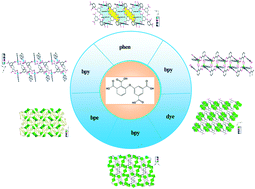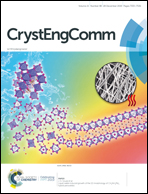Rational design, crystal structures and sensing properties of a series of luminescent MOFs based on a flexible tetracarboxylate ligand and N-donor ligands†
Abstract
Six Zn/Cd metal–organic frameworks (MOFs), {[Zn2(dppa)(bpy)2(H2O)]·H2O}n (1), {[Zn2(dppa)(phen)2(H2O)]·3H2O}n (2), [Cd(H2dppa)(bpy)]n (3), {[Cd2(dppa)(dye)]·H2O}n (4), {[Cd4(dppa)2(H2O)9]·H2O}n (5) and {[Cd2(dppa)(bpe)2(H2O)]·H2O}n (6) (H4dppa = 5-(3′4′-dicarboxylphenoxy)isophthalic acid, phen = 1,10-phenanthroline, bpy = 2,2′-bipyridine, dye = 2,2′-dipyridylamine, bpe = 1,2-bis(4-pyridy) ethane), were synthesized and structurally characterized by elemental analyses, plasma (ICP) spectrometry, IR spectroscopy, and single-crystal X-ray diffraction analyses. 1–3 are 1D ring chains. 4 shows a 2D bilayer network based on a tetranuclear cadmium cluster linked by (dppa)4− ligands. 5 displays a 2D bilayer network based on a trinuclear cadmium cluster, in which (dppa)4− ion shows two different coordination modes. In contrast to the above MOFs, 6 possesses a 3D network structure based on dinuclear cadmium units cross-linked by (dppa)4− and bpe ligands. For 1–6, weak hydrogen bonding and π⋯π stacking contacts link the discrete 1D chains or 2D networks to form high-dimensional supramolecular structures. Especially, in 1–6, (dppa)4− ligand displays seven different coordination modes and conformations, which may show natural synergy in the structural diversity of the resulting MOFs. The remarkable characteristic of these frameworks is that 2 demonstrates highly selective and sensitive bifunctional luminescent sensing towards acetone and Fe3+ ion. In addition, the thermal stabilities and luminescence properties of the MOFs were studied.



 Please wait while we load your content...
Please wait while we load your content...